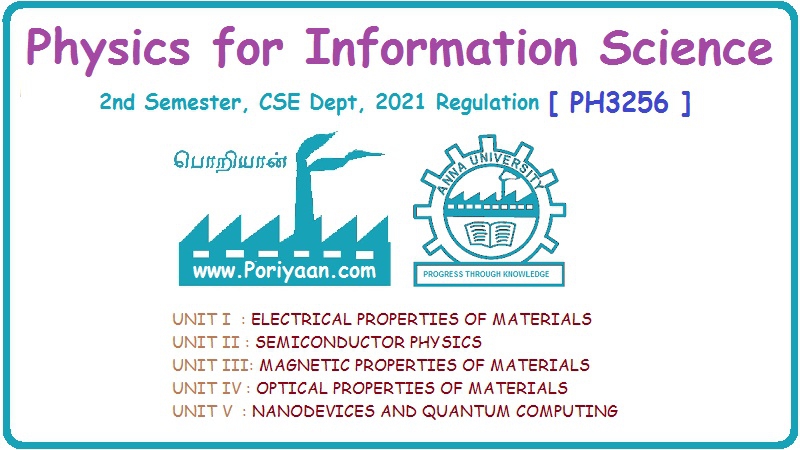Physics for Information Science: Unit III: Magnetic Properties of Materials
Domain Theory of Ferromagnetism
The domain in ferromagnetic solid is understandable from the thermodynamical principle, (i.e.,) in equilibrium the total energy of the system is minimum.
DOMAIN
THEORY OF FERROMAGNETISM
The
domain in ferromagnetic solid is understandable from the thermodynamical
principle, (i.e.,) in equilibrium the total energy of the system is minimum.
For this, first we consider the total energy of the domain structure and then
how it is minimised. The total energy of the domain comprises the sum of
following energies. viz.
(i) Exchange energy
(ii)
Anisotropy energy
(iii)
Domain wall energy
(iv)
Magneto-strictive energy.
(i) Exchange energy (or) magnetic field energy (or) magneto-static energy
The
interaction energy which makes the adjacent dipoles to align themselves is
known as exchange energy (or) magnetic field energy. The exchange energy has
established a single domain in a specimen of ferromagnetic and it is shown in
Fig. 3.17.
Because
of the development of the free poles at the ends of the domain, an external
field will be produced around it and the configuration will have a high value
of magnetic field energy. In other words it is the energy required in
assembling the atomic magnets into a single domain and this work done is stored
as potential energy.
The
magnetic energy can be reduced by dividing the specimen into two domains as
shown in Fig. 3.18 and 3.19. The process of subdivision may be carried further,
until the reduction of magnetic energy is less than the increase in energy to
form another domain and its boundary. This boundary is called as domain wall
(or) Block wall.
Note:
Closure domains: The triangular domains complete the flux path and hence will not produce any poles. Therefore there is no magnetic field associated with the magnetisation. These domains are called closure domains. It is shown in Fig. 3.20.
(ii) Anisotropy energy
In
ferromagnetic crystals there are two directions of magnetisation. viz,
(i)
Easy direction (ii) Hard direction
In
easy direction of magnetisation, weak field can be applied and in hard
direction of magnetisation, strong field should be applied. For producing the
same saturation magnetisation along both the hard and easy direction, strong
fields are required in the hard direction than the easy direction.
For
example in Iron easy direction is [100], medium direction is [110] and the hard
direction is [111] and it is as shown in Fig. 3.21. From the figure we can see
that very strong field is required to produce magnetic saturation in hard
direction [111] compared to the easy direction [100].
Therefore the excess of energy
required to magnetise the specimen along hard direction over that required to
magnetise the specimen along easy direction is called Crystalline anisotropy
energy
(iii) Domain wall energy (or) Bloch wall energy
Bloch
wall is a transition layer which separates the adjacent domains, magnetised in
different directions. The energy of domain wall is due to both exchange energy
and anisotropic energy.
Based
on the spin alignments, two types of Bloch walls may arise, namely (i) Thick
wall (ii) Thin wall
Thick Wall:
When the spins at the boundary are misaligned and if the direction of the spin
changes gradually as shown in Fig. 3.22, it leads to a thick Bloch wall. Here
the misalignment of spins are associated with exchange energy.
Thin Wall:
When the spins at the boundaries changes abruptly, then the anisotropic energy
becomes very less. Since the anisotropic energy is directly proportional to the
thickness of the wall, this leads to a thin Bloch wall.
Note:
The Bloch wall should have thickness, balancing these two energies.
(iv) Magnetostrictive energy
When
the domains are magnetised in different directions, they will either expand
(or) shrink. Therefore there exists a deformation (i.e.,) change in dimension
of the material, when it is magnetised. This phenomenon is known as
magnetostriction and the energy produced in this effect is known as
magnetostriction energy.
The
deformation is different along different crystal directions and the change in
dimension (increase or decrease) depends upon the nature of the material. For
example, in Ni the length decreases; and in permalloy the length increases. But
both the increase (or) decrease is due to the mechanical stress generated by
domain rotation.
Physics for Information Science: Unit III: Magnetic Properties of Materials : Tag: : - Domain Theory of Ferromagnetism
Related Topics
Related Subjects
Physics for Information Science
PH3256 2nd Semester CSE Dept | 2021 Regulation | 2nd Semester CSE Dept 2021 Regulation
